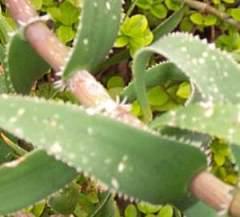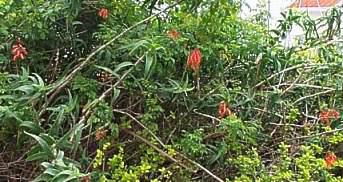Aloiampelos ciliaris var. ciliaris
Aloiampelos ciliaris (Haw.) Klopper & Gideon F.Sm. var. ciliaris
Family: Asphodelaceae
Common names: climbing aloe (Eng.); rank-aalwyn (Afr.)
Introduction
Aloiampelos ciliaris var. ciliaris is a small, handsome, climbing aloe and one of the easiest to cultivate. It was previously called Aloe ciliaris var ciliaris but along with other small shrubby scrambling aloes has been moved to the genus Aloiampelos.

Description
Description
Aloiampelos ciliaris var. ciliaris is sparsely branched, climbing to 10 m or even higher. The base can sometimes be multistemmed and with age may become a rounded, swollen caudex up to 150 mm in diameter, bearing grey bark.
Roots are shallow, fleshy and about 5 mm in diameter, radiating from the swollen base. Stems lying on the ground will root. Its leafy, elongated stems are 8-12 mm in diameter, initially green and covered by the amplexicaul, striated leaf bases which become dry, papery and grey with age. This covering eventually also erodes, exposing its grey bark.
The spirally arranged green leaves are leathery but softly succulent, linear-lanceolate 50-152 x10-30 mm, bearing small white teeth extending right around the leaf base. The leaf sap is not bitter as found in so many other aloe species. The internodes are 15-30 mm apart but the leaves tend to be more crowded at the ends, forming a loose rosette up to about 150 mm in diameter.
The inflorescence is a simple, ascending raceme, 150-300 mm long, appearing near the branch ends, and racemes are 50-120 mm long. The tubular flowers are 28 x 8 mm. The oblong fruiting capsule is about 18 mm long. Flowering time is almost throughout the year but with a peak in spring.

Distribution and habitat
Distribution description
Aloiampelos ciliaris var. ciliaris is widespread in the Eastern Cape thicket vegetation occurring from Uitenhage in the south to the Kei River mouth in the north east. Plants are often confined to dry river valleys. The plants grow in thorny thickets dominated by succulent plants. Its habitat varies from level ground to rocky areas. The plants are usually scandent, the stems ascending and little branched and climbing to the thicket canopy, producing its showy racemes usually fully extended in full sun. Here the climate is dry and hot and frost very light or absent. Rainfall is mainly during the warmer summer months ranging between 500-600 mm per annum. Winters are dry, but with occasional cold fronts and winter rain.
Derivation of name and historical aspects
History
The genus Aloiampelos consists of seven species; Aloiampelos ciliaris, A. commixta, A.decumbens, A. gracilis, A.juddii, A. striatula, and A. tenuior. There are two other varieties of A. ciliaris, namely, A. ciliaris var. redacta and A. ciliaris var. tidmarshii. Our variety of this species differs from the others in this group by being the only true climbing spcies. It is also the fastest growing of all.
Aloiampelos are closely related to aloes which, with few exceptions, are confined to Africa and its islands. They belong to the family, Asphodelaceae subfamily Alooideae, and other well-known members include Aloe, Aloidendron, Gasteria and Haworthia, Astroloba and Poellnitzia.
The specific epithet ciliaris pertains to its marginal teeth arranged like an eyelash and extending right around the base of the amplexicaul leaf. In habitat the plant is variable in leaf size and smaller and larger forms occur. Aloiampelos ciliaris var. ciliaris differs from A. ciliaris var. tidmarshii, a somewhat similar looking, multistemmed shrub, 1.0-1.5 m tall, by its climbing nature and marginal teeth which are continuous round the base of the leaf.
According to Dr G.W. Reynolds, Aloiampelos ciliaris var. ciliaris was first collected by John Burchell, a well-known English traveller, on 9 Oct. 1813 in the Port Alfred District. It was named Aloe cilliaris var. ciliaris by the succulent plant botanist, Adrian Haworth in 1825. Molecular research has lead to the recent name change.
Ecology
Ecology
The conspicuous, bright orange-red flowers of Aloiampelos ciliaris var. ciliaris are pollinated by sunbirds. The slender stems and often recurved leaves aid in anchoring the plant. The plant has a shallow root system utilising the upper humus-rich soil layer. Water is stored in its fleshy stems and leaves which helps the plant during droughts. It is a well-known fact that climbing plants are rapid growers; They do not have to invest energy in woody characters, but can use their energy in quick growth, and by leaning on other woody vegetation, rapidly reach the canopy, exposing their leaves to the sun. Aloes are usually slow growers, but this species is the exception.

Growing Aloiampelos ciliaris var. ciliaris
Grow
This is a tough and versatile garden plant for frost-free areas. It is best planted at the base of a shrubbery or fence. It will soon climb to the canopy and produce its handsome flowers. Cuttings can be planted straight into the ground at base of the shrubs or at 1.5 m intervals along fences. It will also scramble up in a hedge. It is not resistant to heavy frost. It also thrives in containers, but needs support for its weak stems. It is not shy to flower and thrives on organic food such as compost. The plants are drought tolerant, but will also grow well in high rainfall regions, where they should be planted in a well-drained spot. It is tolerant of a wide range of soil conditions and also grows well in winter rainfall Western Cape gardens.
Probably the easiest of all aloes, a branch can simply be cut and planted in a container or in the garden and will rapidly grow. It can also be grown from seed like all other Aloiampelos and Aloe species. Seed is best sown during spring or summer. The young plants grow quite fast and can be planted out within a year.
Sow in a sandy, well-drained potting soil in a warm shady position in standard seed trays. Germination is within three weeks. Cover with a thin layer of sand (1-2 mm) and keep moist. The seedlings can be planted out in individual bags as soon as they are large enough to handle. Flowering occurs within 2-3 years.
References
- Reynolds, G.W. 1950. The aloes of South Africa. Trustees of the Aloes of South Africa Book Fund, Johannesburg.
- Manning J, Boatwright J.S. 2014.A Molecular Phylogeny and Generic Classification of Asphodelaceae subfamily Alooideae.Systematic Botany (2014), 39(1): pp. 55–74
- Grace, O.M., Klopper, R., Smith, G.F., Crouch, N.R., Figueiredo, E., RØnsted, N.E. & Van Wyk, A.E. 2013. A revised generic classification for Aloe (Xanthorrhoeaceae subfam. Asphodeloideae). Phytotaxa 76,1: 7–14.
Credits
Ernst van Jaarsveld
Kirstenbosch National Botanical Garden
September 2003
Updated Y Reynolds July 2015.
Plant Attributes:
Plant Type: Climber, Succulent
SA Distribution: Eastern Cape, Western Cape
Soil type: Sandy, Loam
Flowering season: Spring, Sporadic/All year
PH: Acid, Neutral
Flower colour: Orange
Aspect: Full Sun, Shade, Morning Sun (Semi Shade)
Gardening skill: Easy
Special Features:
Horticultural zones











Rate this article
Article well written and informative
Rate this plant
Is this an interesting plant?
Login to add your Comment
Back to topNot registered yet? Click here to register.